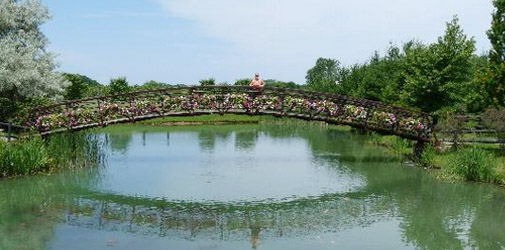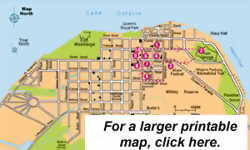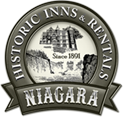Niagara on the Lake
Welcome to the city guide of Niagara-on-the-Lake. Find the latest information, accommodations, attractions, bed and breakfasts and more. Whether your visit is for a day or longer or whatever is your likes and dislikes, there are innumerable options waiting in the historic Niagara on the Lake for every visitor. Go through our website. Find best hotels and motels , bed and breakfasts, campgrounds, rentals and a host of other activities that are available in the Niagara-on-the-Lake.
Being one of the prettiest towns in Canada and the center of tourism in the region, Niagara-on-the-Lake plays a key role. Beautiful setting, forts, river, arts, historical sites, grand mansions, gardens and parks all that make Niagara-on-the-Lake a wonderful place to visit.
The Niagara-on-the-Lake is also one of the most fascinating historical place that even goes back to the history of early Ontario. The town still retains its 19th century charm and the ambiance of the Victorian era.
The region is acclaimed for its grapes, cherries and peaches. Wineries in the region offer excellent wine and cuisine that keeps growing its visitors number each year. It will be wrong to portray the great Niagara-on-the-Lake with a single description. Nature, wine, food, theatre and history, the long list of attractions of Niagara-on-the-Lake extends. Take a horse ride, jet boat travel, golf, the recreation trails, biking, hiking and historical sites, there are so much things to do in Niagara-on-the-Lake .

Choose from one of the many getaway packages, accommodations, vacation deals, guided tours , wineries and make your Days in Niagara-on-the-Lake an unforgettable experience! Explore the past get to know more about Niagara on the Lake. Find attractions, festivals, events, hotels & On-the-Lake Wineries.
Remember your whole trip to
Niagara-on-the-Lake can be booked through INFO Niagara!
Niagara-on-the-Lake Walking Tours
The following suggested walking tour was taken from the book Exploring Niagara by Hans Tammemagi. It's a great way to explore the charm of Niagara-on-the-Lake.
This walk starts from the north side of Simcoe Park, where there is usually ample free parking, except at peak summer tourist times. The walk itself will take about one hour: however, there are many interesting stops that can easily add several more hours. The walk explores, with a small detour, the areas to the east of King Street. Please refer to the map below; the numbers on the map correspond to the numbers in the following text.
Start by crossing to the north side of Byron Street to St. Mark's Church (1), which was originally built between 1804 - 1809. Used as a hospital during the War of 1812, this Anglican church was burned by the retreating American soldiers in 1813 but was rebuilt by 1822. The oldest library in Upper Canada (now Ontario) is in the Rectory with books dating from the 16th century. The churchyard of St. Marks was the earliest burial ground in the town, and contains many fascinating tombstones from the early nineteenth century.
Proceed east along Byron Street to Fort George (2). The wooden palisades look remarkably frail in contrast to the sturdy stone walls and buttresses of the rival Fort Niagara on the American side of the river. Built by the British between 1796 and 1799 to guard the entrance to the Niagara River, Fort George played a strategic role in the War of 1812 and was used by General Isaac Brock as the base for British military operations in the area. The fort was overrun and burned by the Americans in May 1813. More than a century later during the Great Depression, the fort was restored to the original specifications of the Royal Engineers as a make-work project. All 11 of the original 14 buildings restored are furnished as they were from 1797 to 1813; all hardware used in the restoration was made by hand at Fort George in the Artificer's Shop. It is particularly delightful to visit the Fort on Canada Day or other special occasions when the sound of muskets and the smell of gunpowder are heavy in the air as battles of the War of 1812 are re-enacted by townsfolk in period costumes.
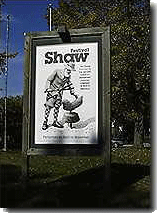
Walk back toward Town along Queens Parade until you reach the Shaw Festival Theatre(3), which is on the left. Begun in 1962, the Shaw Festival has gained an international reputation for excellence. Plays by George Bernard Shaw and his contemporaries are presented each season from April until October. The theatre was built in 1972 to accommodate the intense demand for tickets that caused it to outgrow the tiny Court House Theatre, where it began.
Continue toward Town and at Wellington Street, cross over and visit St. Vincent de Paul Church (4). The oldest part of the church was completed in 1834. The first catholic mass was celebrated in Niagara-on-the-Lake in 1669. The church was renovated in 1890 and again in 1964.
Cross back over Picton Street and continue south along Wellington, turning right when it ends at Castlereagh Street. Soon on the right is the Niagara Historical Society (5). Founded in 1895 and housing over 20,000 artefacts, this structure was the first in Ontario to be built solely as as museum.
Continue along Castlereagh Street to King Street and turn right. At Queen Street make a left turn keeping on the left side of Queen Street. At the intersection take a moment to admire the Clock Tower, which was erected as a memorial to the soldiers who lost their lives in the First World War and provides the focal point of the main street. On the southeast corner is the Prince of Wales Hotel (7), which was built in 1880.
At 26 Queen Street is the Court House (8), which was built in 1847 on the site of the Government House (1792). It has one of the oldest town bells in Canada, which has rung continuously on the hour since March 27, 1839. Not used for judicial purposes since 1862 when the county seat was moved to St. Catharines, the Court house was the original home of the Shaw Festival and is still used as a venue for plays.
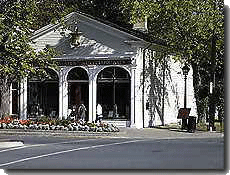
Cross over Queen Street and return on the other side. The Niagara Apothecary (9) is located at 5 Queen Street. Built in 1819, this building served continuously as a pharmacy, dispensing remedies and cures to the ill until 1971 when it received a major facelift and was converted to a museum. It has the honour of being the longest operating pharmacy in Ontario. Much of the original apothecary-ware has been re-acquired, including patent medicines, leech containers, and cure-all tonics that promise to alleviate tooth ache, cholera, indigestion, rheumatism, gout, diarrhoea, and many other maladies. Original fixtures such as black walnut counters and crystal chandeliers are a contrast to the sterile interiors of modern super drug stores.
Turn left at King Street and proceed to 177 King Street, the Preservation Fine Art Gallery(10), a delightfully restored Victorian mansion, which houses work by the popular local artists Trisha Romance, Alex Colville, and Philip Graig. The house alone makes a visit worthwhile.
Across the street is Simcoe Park with tall and elegant shade trees under which you can rest, perhaps enjoying a picnic, while you recover from your walk.
Niagara on the Lake , also known as Canada's most Haunted Town, is the only spot in Canada for ghost walks and ghost tours.
Niagara-on-the-Lake History
The settlement was originally known as Butlersburg, in honour of Colonel John Butler, the commander of Butler's Rangers.
The Town received official status in 1781 when it became known as Newark, a British military site and haven for British loyalists fleeing the United States in the volatile aftermath of the American Revolution.
Later, it changed names again, this time to Niagara.
Niagara was named the first capitol of Upper Canada (now the province of Ontario), and the first provincial parliament was convened at Navy Hall in 1792 by Lieutenant-Govenor John Graves Simcoe.
During the War of 1812, the capitol was moved to York (later to be renamed as Toronto) so as to be farther from the areas of combat.
The Town played a central part in the War or 1812. It was taken by American forces after a two day bombardment by cannons from Fort Niagara and the American Fleet, followed by a bloody battle.
Later in the war the Town was razed and burnt to the ground by American soldiers as they withdrew to Fort Niagara. Undaunted by this setback, the citizens rebuilt the Town after the War, with the residential quarter around Queen Street and toward King Street, where the new Court House was rebuilt out of firing range of the cannons of Fort Niagara.
In the 1880's, the Town was renamed as Niagara-on-the-Lake to avoid confusion with Niagara Falls. The central part is referred to as Old Town or Old Niagara.
Explore the past. Get to know more about Niagara on the Lake.

